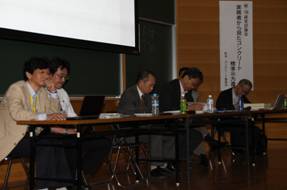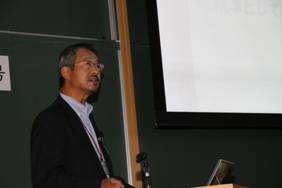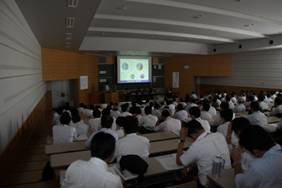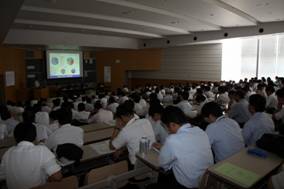 Moderator: T. Miyagawa (Kyoto University) Panelist: T. Ishibashi (East Japan Railway Company) R. Shimizu (MLIT Kyushu Area) S. Sogo (Obayashi Corporation) Y. Watanabe (Shimizu Corporation) K. Uji (Tokyo Metropolitan University) T. Shimomura (Nagaoka University of technology) First of all, Prof. Miyagawa, the chairman of concrete committee, made the opening remarks, especially on the requirements of concrete structures and their standard specifications. He said the current specifications consisting of several parts are designed for all engineers: for instance, “design part” is for design engineers, “construction part” for construction engineers and “maintenance part” for managing engineers. He also pointed out that this separation may lead to miscommunication among the engineers. –“Moreover, standardization may also contribute to uniformity and homogenization of construction and structures in time and space. This generalization may also make it difficult for users to understand the specifications. Meanwhile, each part of the standard specifications consists of two divisions: “performance verification” and “normal specifications." The standard specifications of JSCE are supposed to be applied to individual cases by modifying the details according to the practical conditions so that the modified specifications satisfy the performance verification. Prof. Miyagawa then requested the panelists to comment on these issues first. |
Ishibashi: He gave a brief introduction of the basic policy to revise the specifications and pointed out two important issues: the revival of responsible engineers and the division of each part of the specifications. – “First, although the responsible engineer was eliminated in the previous specifications, the role of a responsible engineer has been revived in the current specifications because now it seems to be difficult to ensure the quality of concrete just by referring to the standards and there is a need forengineers who attend to each processon his own responsibility. The other important issue is to divide the specifications into two divisions such as “performance verification” and “normal specifications." The performance verification is to specify the fundamental rules and principle, while the normal specifications refers to one application example of the performance verification. Especially in the material and construction part, the normal specifications also consist of two parts: construction part and inspection part. The construction part is designated for the process of construction and in the inspection part the inspection details are prescribed to ensure the quality of concrete structures. Since we think the quality control and the inspection process is different, we need to separate these two things in the specifications. However, the maintenance part does not have the normal specifications division because it has been edited recently. The important thing in the current specifications is to transfer the information concerning the structures and materials to the next stages of plan, design, construction, and maintenance. To clarify the responsibility of each sector – such as planner, designer, constructor and maintenance manager – the specifications are also divided into four parts. A responsible engineer should be present in both sides of client and employee to construct structures on his own responsibility. Moreover, it is prescribed that during construction and inspection, the inspector executes his duty independently from the construction engineer.” Sogo: He expressed his opinion from the viewpoint of construction engineer. He acknowledged that the specifications of 2002 were not useful. He explained some cases of “construction and material part” and reviewed the history of the specifications. |
|
| – “Until 1996, the standard specifications could be easily applied to normal
structures because the standards were just a specifications based code.
However, it was quite difficult to adopt new technologies and also to modify
the criteria. Thus in 2002, the specifications were revised to be a performance-based
code. This revision allowed the specifications to easily adopt a new technology,
but for the engineers, the specifications became difficult to use because
great knowledge and techniques were required to apply and interpret the
specifications. After considering this merit and demerit of a performance-based
code, the specifications based code was revived in the revision of 2007.
But in reality this revival of the specifications-based code was criticized
as counterproductive to development. Moreover, judging from the opinions
and comments on the construction and material part found in the home page
of JSCE, the criteria cited in the normal specifications were regarded
as absolute and unchangeable values, and this indicates the fact that engineers
use the normal specifications part not as an example but absolute application.
There is also an opinion that for engineers to combine these two parts
is too complicated.” Watanabe:As engineers who use the specifications in practical cases, he explained his desire concerning the specifications. He summarized his opinion as follows:
|
 Photo-Mr.Watanabe Uji: He summarized the results of questionnaires about the current specifications. – “About 600 people of various occupations responded to the questionnaires.The answers were submitted by about 600 people having various occupations. From the answers, it wasis found that those who felt difficulty in using use of the specifications did not understand how to use the performance verification, and also the difference between the two divisions. Thus in the next revision, how to use the performance verification should be clarified. As for the criteria and equations cited in the specifications they also pointed out that the basis of these citations should be described. Actually the basis is surely described in the appendix but the problem is that they are not aware of it. The values in the specifications should be recognized basically as one of the examples and applications but these are often regarded as absolute and unchangeable ones. They also felt that the difference between the expression of “should” and “better” (in Japanese) was difficult to understand. As for the responsible engineer, there are several opinions including the positive and negative, but mostly they pointed out that organizations are not ready to accept this system.” Shimomura: He reported the activity of subcommittee regarding the next specifications. – “This subcommittee aimed at preparation and investigation for the next specifications. Throughthis activity, it was clarified that the past revision has particular motivation. For instance in the revisions of 1980’s, the goal of revision was to adopt a limit state design and to reflect the domestic results. As for the revisions of 1990’s, the goal was to build the performance-based design within 10 years according to the world-wide trend of performance design. |
|
| However, now there is no clear motivation for the next revision. Throughout the discussion on the next specifications, they proposed a vision for the next specifications. The proposed vision mainly emphasizes having the part of “common” and “principle." Basically the common part indicates the performance based standard as in the current version, but the principle denotes a higher concept such as idea and goal which will be used for the accountability to general people.” Shimizu:He explained the development of laws concerning the standard specifications, and then introduced the specifications that were specially adapted for the Kyushu area. Kyushu area has its own characteristics so sometimes the conventional standards are not suitable. Thus they prescribed their own specifications for construction of concrete structures in the Kyushu area. These specialized specifications are similar to the standard specifications of Kyushu area. So far the specifications have been applied to several pilot constructions to for verification.  |
After the end of individual presentations, the panel moved on to the discussion. First, Prof. Miyagawa commented on the separation of standards, “performance verification” and “normal specifications." He said the performance-based specifications are not needed for most structures.
Miyagawa: “They just need “normal specifications” for their design and construction but some important or specialized structures require performance-based designs. Basically the intension of those who edit the current specifications is to promote users to create their own specifications based on the performance verification. Namely, the normal specifications are just examples. However in reality, most engineers simply refer to the normal specifications and they never try to create their own." About this point, Prof. Miyagawa asked for a comment from Prof. Wakatake who is a committee member of Kyushu standards, which are local standards specified in Kyushu area. Prof. Wakatake explained the Kyushu standards to point out that in Kyushu area they rarely experience freezing deterioration but chloride ion attack is quite severe due to use of sea sands. He also commented that Kyushu's high temperatures as compared to other areas should be considered since this may cause temperature cracks. Another characteristic of their standards is the description of local materials such as Shirasu. They evaluate their standards by applying it to real construction and ask a third party to check it for sufficient quality. These standards can be downloaded from the homepage of administration office of Kyushu area. |
|
| Prof. Myiagawa also asked Prof. Hisada who has been involved in the maintenance of Tohoku area with local administrators
about the specifications adopted for the Tohoku area. Prof. Hisada said
they often have freezing deterioration and the ministry office plans to
publish the Tohoku version with reference to the Kyushu standards. Mr.Sogo
suggested that the image of structures should be unified and clearly described
in the next specifications to avoid misunderstanding among the engineers.
He also illustrated some drawbacks due to the segregation of design and
construction in the specifications. Sogo: “When the material used in construction is different from that in design, the numerical analysis, for instance temperature stress, should be conducted again during construction.” Ishibashi: “The separation between design and construction in the specifications enhances the responsibility of both engineers and the information in design must be transferred to the engineers of the construction. Thus if the material is different, it is the responsibility of the construction engineers to re-calculate .” Shimomura: “In the other debate session of this conference, they also discussed “common part” of the prospective specifications, but they focused on the philosophical principle.” Kawai (chief manager of subcommittee): “"principle part" contains the philosophical principle for civil engineers as well as for laymen. In this meaning, we propose the "principle part" to distinguish from the "common part"." Miyagawa: "Who is the assumed reader of the "principle part"?" Kawai: “General people. However, even for the engineers it is sometimes difficult to consult the standards due to its huge volume and detailed contents. Thus the engineers are also supposed to use the "principle part" as a reference.” |
Miyagawa: “Is there any comment on the different shrinkage values between now and
before?” Sogo: “As a member of JCI committee, I can say that the shrinkage criterion of current specifications is specified as 1200 microns for civil structures, but for architectural structures , 800microns is adopted as their criterion. This segregation may cause some confusion in fresh concrete production industry because they produce fresh concrete for both areas. Thus the committee is organized in JCI because JCI consists of civil and architectural engineers. Besides, I am also of the opinion that the results of advanced and latest researches should be reflected in the specifications.” Prof. Sakata who is president of Japan Concrete Association also commented in this discussion: “Once we propose the value of 800 microns, this value will be simply applied without referring to other important information and will finally be regarded as the absolute and unchangeable criterion. As for the utilization of advanced data, it is of course granted to consider the advanced results when the standards are edited, but we should also know that there will be some gap between reality and such a result because the result is often obtained in a laboratory. Thus engineers should read between the lines and modify and adapt them to accommodate the reality.” Watanabe: “I know of several studies based on real structures in the United States. I would like to ask researchers to take a look at the real site.” Ishibashi: “In the revision of 2007, there were more academics in the committee than before. But I think more practical engineers should join the committee to edit the standards to point out the controversies between the laboratory and the real site. When practical engineers are faced with a difficult situation during construction, they often evade such difficulty by switching to an easier solution. But this evasion may decelerate improvement and development of technology, and thus the practical engineers should consult with the researchers to discuss the difficulties to enhance the experience of both disciplines. Researchers should also listen to the advices of the practical engineers.” |
|
| Miyagawa: “I think the cover of 200 mm is not practical. We also have an issue of congested reinforcement. Can anyone suggest resolution to these issues?” Watanabe: “If the users are getting such extraordinary values by simply following the specifications, the specifications should also show how they can be modified. As for the congested rebars, I would like to five you the historical background. The accuracy of shear strength estimation had been high even before the Hanshin earthquake, but there was a criterion, for instance, about the yield strength of rebar. However, after the earthquake, the standards had been modified to enhance the load bearing capacity without changing the yield strength, which resulted in congested rebars. This can be evaded by using high strength rebars.”  |
Finally, Prof. Miyagawa summarized this debate with his further vision
of the specifications and gave a few keywords as follows:
This forum was closed with applause from the audience.
|
||